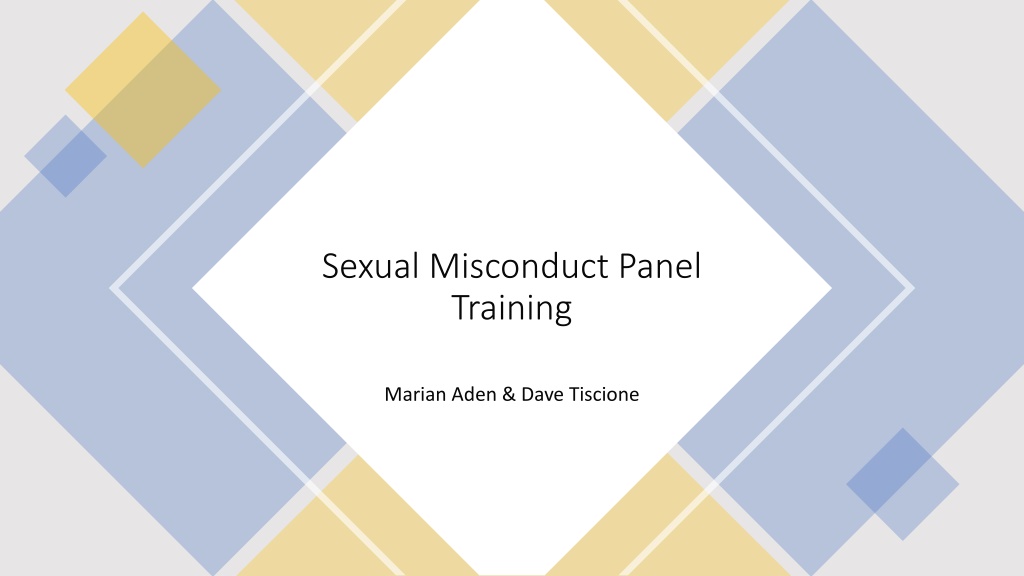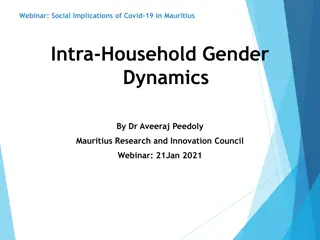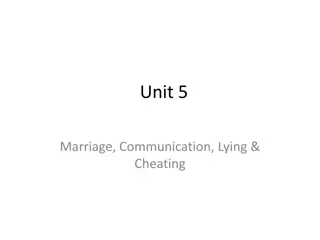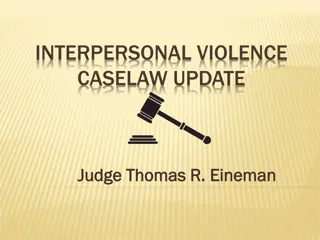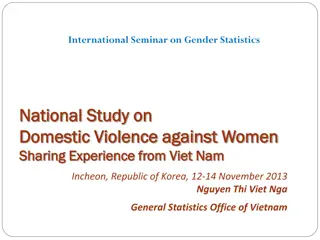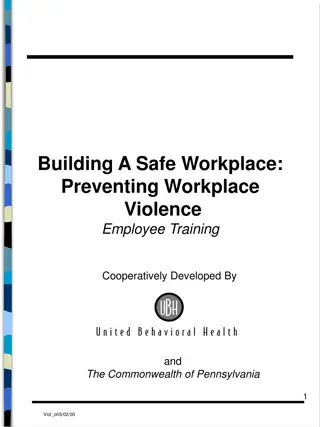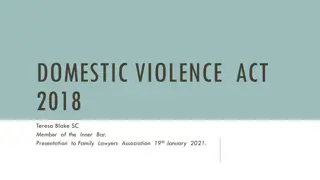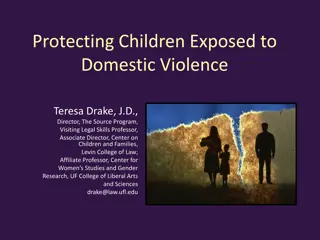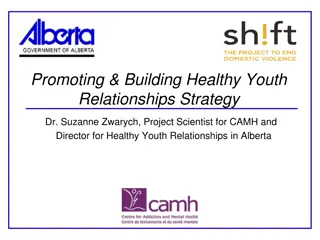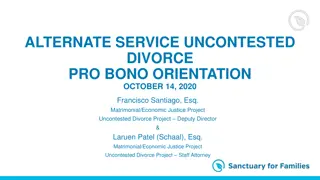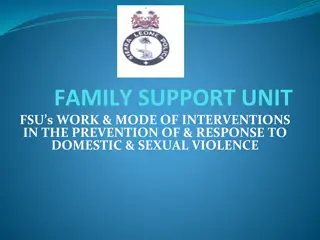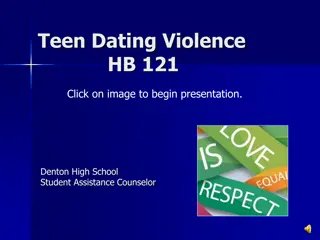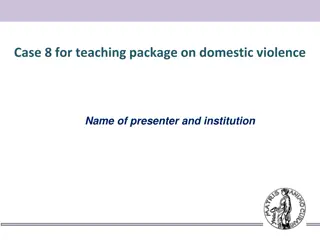Understanding Dating and Domestic Violence Definitions in Training
Explore updated definitions of dating and domestic violence, including behaviors such as sexual assault, physical abuse, and coercion. Learn about assessing criteria for harassment, credibility assessments, and considerations during sanctioning in a panel training setting at Loyola University Maryland. Gain insights into recognizing different forms of abuse and power dynamics in relationships.
Download Presentation

Please find below an Image/Link to download the presentation.
The content on the website is provided AS IS for your information and personal use only. It may not be sold, licensed, or shared on other websites without obtaining consent from the author. Download presentation by click this link. If you encounter any issues during the download, it is possible that the publisher has removed the file from their server.
E N D
Presentation Transcript
Sexual Misconduct Panel Training Marian Aden & Dave Tiscione Loyola University Maryland Internal Use Only
Training Overview Updated Definitions- Dave Dating Violence Consent Assessing Criteria for Sexual Harassment Severe, Pervasive, and Objectively Offensive (SPPOO)- Dave Case Studies- Marian Revisiting Credibility Assessments- Marian Things to Consider during Sanctioning- Marian Loyola University Maryland Internal Use Only
Dating/Domestic Violence Definition Updates Dating Violence encompasses a wide range of behaviors including sexual assault, physical abuse and other forms of violence violencecommitted by a committed by a person who is or has been in a social relationship of a romantic or intimate nature with the person who is or has been in a social relationship of a romantic or intimate nature with the complainant. complainant. The existence of such a relationship shall be determined based on the complainant s statement and with consideration of the length of the relationship, the type of relationship, and the frequency of interaction between the persons involved in the relationship. For the purposes of this definition, dating violence includes, but is not limited to, sexual or physical abuse or the threat of such abuse. Dating violence does not include acts covered under the definition of domestic violence. Domestic Violence encompasses a wide range of behaviors including sexual assault, physical abuse and other forms of violence of violencecommitted by a current or former spouse or intimate partner committed by a current or former spouse or intimate partner of the complainant; by a person with whom the complainant shares a child in common whom the complainant shares a child in common; by a person who is cohabitating with or has cohabitated with, the complainant as a spouse or intimate partner complainant as a spouse or intimate partner; by a person similarly situated to a spouse of the complainant person similarly situated to a spouse of the complainant, or by any other person against an adult or youth complainant protected from those acts any other person against an adult or youth complainant protected from those acts by domestic or family violence laws of Maryland. sexual assault, physical abuse and other forms of sexual assault, physical abuse and other forms who is cohabitating with or has cohabitated with, the Loyola University Maryland Internal Use Only
Dating/Domestic Violence Definition Updates Violence under dating violence and domestic violence includes but is not limited to The use or attempted use of physical abuse or sexual abuse A pattern of any other coercive behavior committed, enabled, or solicited to gain or maintain power and control over a victim Including verbal, psychological, economic, or technological abuse. Economic abuse means behavior that is coercive, deceptive, or unreasonably controls or restrains a person s ability to acquire, use, or maintain economic resources to which they are entitled, including using coercion, fraud, or manipulation to restrict a person s access to money, assets, credit, or financial information; unfairly use a person s personal economic resources, including money, assets, and credit, for one s own advantage; or exert undue influence over a person s financial and economic behavior or decisions, including forcing default on joint or other financial obligations, exploiting powers of attorney, guardianship, or conservatorship, or failing or neglecting to act in the best interests of a person to whom one has a fiduciary duty. Technological Abuse means an act or pattern of behavior that is intended to harm, threaten, intimidate, control, stalk, harass, impersonate, exploit, extort, or monitor, except as otherwise permitted by law, another person, that occurs using any form of technology, including but not limited to: internet enabled devices, online spaces and platforms, computers, mobile devices, cameras and imaging programs, apps, location tracking devices, or communication technologies, or any other emerging technologies. Loyola University Maryland Internal Use Only
Fondling Definition Updates Fondling is another form of sexual assault which is defined as the touching of the private body parts, including but not limited to breasts, buttocks, or groin of another person, for the purpose of sexual gratification, without the consent of the complainant, including instances where the complainant is incapable of giving consent because of their age or because of their temporary or permanent mental incapacity This would include someone (person A) making another person (person B) touch their (person A) private body parts sexually without their (person B) consent. Loyola University Maryland Internal Use Only
Consent Consent is defined as an affirmative indication by words and/or actions of a voluntary agreement to engage in the particular sexual act or conduct in question. Consent for one sexual act or conduct does not constitute consent to all sexual acts or conduct. Consent can be withdrawn at any time, and once withdrawal of consent has been expressed, sexual activity must cease. Consent cannot be obtained through the use of force, threat, intimidation, or coercion. Coercion is unreasonable pressure for sexual activity and will be determined by the frequency, intensity, context, and Coercion is unreasonable pressure for sexual activity and will be determined by the frequency, intensity, context, and duration of the pressure. duration of the pressure. Silence or absence of resistance on the part of an individual does not constitute their consent. Consent cannot be given by someone who is incapacitated due to consuming drugs or alcohol or for any other reason (including but not limited to being unconscious, asleep, or otherwise unaware that sexual activity is occurring). Incapacitation is a state where someone cannot make rational, reasonable decisions because they lack the capacity to give knowing consent (e.g., to understand the who, what, when, where, why or how of their sexual interaction). While incapacitation may result from the use of alcohol and/or drugs, incapacitation is a state beyond drunkenness or intoxication. Incapacitation may also exist because of a physical, mental, or developmental disability. The question of incapacitation will be examined objectively from the perspective of the respondent i.e., whether a reasonable, sober person in place of the respondent should have known the condition of the complainant based on the apparent indications of incapacitation, which may include, but are not limited to, acting confused or incoherent, difficulty walking or speaking, and vomiting. Loyola University Maryland Internal Use Only
Assessing Criteria for Sexual Harassment Severe, Pervasive, and Objectively Offensive (SPOO) Loyola University Maryland Internal Use Only
Sexual Harassment Policy Sexual Harassment defined as conduct on the basis of sex which may include such behavior as unwelcome sexual advances, requests, and other verbal, written, or electronic communications or physical conduct of a sexual nature when (1) an employee of the University conditions the provision of an aid, benefit, or service of the University on an individual s participation in the unwelcome sexual conduct; or (2) unwelcome conduct determined by a reasonable person to be so SEVERE, PERVASIVE, AND OBJECTIVELY OFFENSIVE that it effectively denies a person equal access to the University s education program or activity. Loyola University Maryland Internal Use Only
Severe Depends largely on the nature and scope of the alleged conduct Can also look at its impact. Some physical conduct does not require repetition to qualify as severe. Any single act of penetration, anal, oral or vaginal, will automatically be seen by most courts as sufficiently severe. Covered under sexual assault and fondling If behavior is humiliating, threatening, or violent, heightens the severity of the incident Comments, jokes, classroom comments, online postings, photographs, etc. are typically not, on their own, sufficiently severe to create a hostile environment. Offensiveness and severity are linked. That which is merely offensive, rather than objectively offensive, is unlike to meet the test for severity. Adapted from ATIXA Playbook Loyola University Maryland Internal Use Only
Pervasive How widespread, openly-practiced, prevalent, and/or distributed the conduct is. Unwelcome sex- or gender-based conduct that is well-known among students or employees can qualify as pervasive. Conduct that occurs in public spaces is more pervasive than conduct in private. Online, electronic, or social media postings and conduct, which often spread rapidly and widely, heighten the pervasiveness by which offensive and unwelcome content can be disseminated. Adapted from ATIXA Playbook Loyola University Maryland Internal Use Only
Objectively Offensive Apply the the reasonable person standard Context matters Would a reasonable person in the context in which the conduct occurred deem the conduct to be objectively offensive? Both subjective and objective elements are necessary in finding a hostile environment. Subjective element is often satisfied by determining whether the recipient (either the intended target, or an offended third party) found the conduct unwelcome. Unwelcome isn t the same thing as offensive, but many behaviors that are unwelcome are so because they are offensive. Elements to examine include, but are not limited to: The age and relationships of those involved; The frequency of the conduct The severity of the conduct Whether the conduct is physically threatening, humiliating, ridiculing, intimidating, or abusive The number of persons involved. Critical to remember is that just because conduct offends, is mean, or is hateful, does not mean it creates a hostile environment Adapted from ATIXA Playbook Loyola University Maryland Internal Use Only
Would you like to take a 5 min break or move through? Loyola University Maryland Internal Use Only
While in Complainants residence hall room, Respondent allegedly engaged in unwelcome touching, kissing, and taking pictures of Complainant s feet all while Complainant was intoxicated and asleep. Respondent allegedly promised to provide alcohol to the Complainant in order to gain access to Complainant s room. Respondent then over-served Complainant alcohol until he passed out. The Respondent has also been the subject of complaints about several incidents of touching others feet in public without consent. Case Study 1- Is this Severe, Pervasive, and Objectively Offensive? Loyola University Maryland Internal Use Only
While in Complainants residence hall room, Respondent allegedly engaged in unwelcome touching, kissing, and taking pictures of Complainant s feet all while Complainant was intoxicated and asleep. Respondent allegedly promised to provide alcohol to the Complainant in order to gain access to Complainant s room. Respondent then over-served Complainant alcohol until he passed out. The Respondent has also been the subject of complaints about several incidents of touching others feet in public without consent. Case Study 1- Is this Severe, Pervasive, and Objectively Offensive? Not SPOO, even if proven. Where pervasiveness is an indispensable element of the offense, a single incident like this won t be enough to meet that element, even accepting severity and objective offense, for the sake of argument. Loyola University Maryland Internal Use Only
During class, a Professor assigned homework that required students to watch a show on Netflix that depicts numerous sexual acts (including same sex acts, which the complaining student mentioned as one of their objections to the assignment), nudity, drug use, suicide, marital infidelity, etc. The student found the content to be disturbing. The student is a devout Catholic and was so appalled they went to confession and reported the matter to the Title IX Coordinator. The department chair informed the Title IX Coordinator that the Netflix show did not meet any learning objectives and the professor could have chosen a variety of content through university resources. Case Study 2- Is this Severe, Pervasive, and Objectively Offensive? Loyola University Maryland Internal Use Only
During class, a Professor assigned homework that required students to watch a show on Netflix that depicts numerous sexual acts (including same sex acts, which the complaining student mentioned as one of their objections to the assignment), nudity, drug use, suicide, marital infidelity, etc. The student found the content to be disturbing. The student is a devout Catholic and was so appalled they went to confession and reported the matter to the Title IX Coordinator. The department chair informed the Title IX Coordinator that the Netflix show did not meet any learning objectives and the professor could have chosen a variety of content through university resources. Case Study 2- Is this Severe, Pervasive, and Objectively Offensive? Could be SPOO, if proven. Extended and repeated exposure to gratuitous sex-based content could be severe, pervasive, and objectively offensive. The captive audience requirement here enhances the argument for SPOO. While the faculty member has the academic freedom to assign what they want, that s only true if the assignment is both germane to the subject matter and pedagogically appropriate. Here, the department chair s testimony shows that the content was not within those protections, and an opt-out should have been offered to students, at least. Loyola University Maryland Internal Use Only
A female student used SnapChat to ask a male student to have sex with her. He refused. She then responded that she would rape him if he did not have sex with her. He took a screenshot and brought a complaint against her. As a result of the exchange, he is avoiding her on campus and dropped the class in which they were both enrolled. Case Study 3- Is this Severe, Pervasive, and Objectively Offensive? Loyola University Maryland Internal Use Only
A female student used SnapChat to ask a male student to have sex with her. He refused. She then responded that she would rape him if he did not have sex with her. He took a screenshot and brought a complaint against her. As a result of the exchange, he is avoiding her on campus and dropped the class in which they were both enrolled. Case Study 3- Is this Severe, Pervasive, and Objectively Offensive? Could be SPOO, if proven. The content is sex-based; the threat could be severe and objectively offensive, if a reasonable person would consider it a true threat. Her capacity for carrying it out matters, as far as First Amendment analysis is concerned. While the one-time comment itself is not pervasive, the effect arguably is, because he is now avoiding her on campus and has dropped the class. Loyola University Maryland Internal Use Only
Johnny and Mary live next door to one another on a co-ed res hall floor, and Mary complains that Johnny watches pornography in his room very loudly, and that she can hear the videos very clearly through the walls. In fact, she believes Johnny intentionally watches porn at an increased volume when he knows Mary is home. Sometimes if she leaves, Johnny seems to pause the pornography, pokes his head out of his room, watches her walk down the hallway, and she can hear him then return to watching porn. On Tuesday, Mary caught Johnny staring at her while she returned from the showers. She confronted him about this, and he said, I m just getting a mental image. She could then hear him immediately start watching porn in his room. Later, Johnny said to Mary, Thanks for earlier, and smiled. Mary and several of her male and female floor mates (who also are upset with the pornography audio levels) file complaints with the TIXC. Case Study 4- Is this Severe, Pervasive, and Objectively Offensive? Loyola University Maryland Internal Use Only
Johnny and Mary live next door to one another on a co-ed res hall floor, and Mary complains that Johnny watches pornography in his room very loudly, and that she can hear the videos very clearly through the walls. In fact, she believes Johnny intentionally watches porn at an increased volume when he knows Mary is home. Sometimes if she leaves, Johnny seems to pause the pornography, pokes his head out of his room, watches her walk down the hallway, and she can hear him then return to watching porn. On Tuesday, Mary caught Johnny staring at her while she returned from the showers. She confronted him about this, and he said, I m just getting a mental image. She could then hear him immediately start watching porn in his room. Later, Johnny said to Mary, Thanks for earlier, and smiled. Mary and several of her male and female floor mates (who also are upset with the pornography audio levels) file complaints with the TIXC. Case Study 4- Is this Severe, Pervasive, and Objectively Offensive? Not SPOO, even if proven. Johnny is conducting himself lawfully in his private space. If the walls are too thin or his audio levels unreasonably high for the residence hall environment, a disruption charge in the halls may be appropriate. Johnny s use of porn appears to be pervasive but is not severe or objectively offensive. Johnny s comments to Mary are obnoxious, inappropriate, and unwelcomed, and should be addressed to ensure they stop, but are not severe, pervasive, or objectively offensive. Loyola University Maryland Internal Use Only
A group of five women stand outside the cafeteria rating the skankiness of other women as they walk by, using a ten-point scale. They each write their ratings on individual small whiteboards, then hold them up for all to see. They also make comments on the white boards about the number of partners the rated women have had, who they have been with, their preferred positions, etc. The comments are snapped and shared amongst a large group of students watching the spectacle, some of whom know that the comments are accurate, but are not things these women would want widely circulated. Several of the women who are rated file complaints. Case Study 5 - Is this Severe, Pervasive, and Objectively Offensive? Loyola University Maryland Internal Use Only
A group of five women stand outside the cafeteria rating the skankiness of other women as they walk by, using a ten-point scale. They each write their ratings on individual small whiteboards, then hold them up for all to see. They also make comments on the white boards about the number of partners the rated women have had, who they have been with, their preferred positions, etc. The comments are snapped and shared amongst a large group of students watching the spectacle, some of whom know that the comments are accurate, but are not things these women would want widely circulated. Several of the women who are rated file complaints. Case Study 5 - Is this Severe, Pervasive, and Objectively Offensive? This could be SPOO. The conduct is severe and pervasive. It s arguably objectively offensive, but that can really only be determined by pursuing the formal resolution process. Violations of privacy are usually going to satisfy the severity element, but there is likely an interesting First Amendment debate to be had here. Loyola University Maryland Internal Use Only
Would you like to take a 5 min break or move through? Loyola University Maryland Internal Use Only
Revisiting Credibility Assessments Loyola University Maryland Internal Use Only
ATIXA 20- Minutes to Trained: Part 2 Assessing Credibility Part 2: 20-Minutes-to...Trained - ATIXA Loyola University Maryland Internal Use Only
Case Study- Harriet Harriet is the dean of the college. Her son, Bob, just took a job as a maintenance technician for the boiler room. Bob works the night shift and rarely sees Harriet at work. Most people don t even know the two are related. A month after Bob started, Harriet was accused of sexually harassing an employee in her office. Bob happened to be in the outer office working on ventilation at the time the incident allegedly occurred. Harriet vehemently denies the allegation, and Bob is a critical witness. Bob can testify to the demeanor of the reporting party before and after the meeting, and to what he did or did not overhear during their meeting. How is Bob s testimony corroborative of Harriet s testimony? What elements add/detract from Bob s credibility? How might the reporting party bolster their credibility? In the absence of additional, obvious evidence, what other information might help determine Bob s credibility? Loyola University Maryland Internal Use Only
Credibility Examples Reference Document Microsoft Word - TOW 1.16.19.doc (atixa.org) Loyola University Maryland Internal Use Only
Considerations during Sanctioning Loyola University Maryland Internal Use Only
10 Questions to Consider What is the core issue in the complaint? What institutional or community resources could provide learning/growth in the core issue area? Is this a first violation or part of a pattern? What is appropriate for our community s behavior standards and expectations (precedent) Did the Respondent provide any compelling information regarding mitigating information regarding sanction severity or impact? Who was harmed by this behavior? How were they harmed? In what ways could the Respondent repair the harm they caused? Did the Complainant provide any compelling information regarding aggravating factors that would impact sanction severity or impact? Are there ongoing safety concerns for the Complainant? For the Community? Loyola University Maryland Internal Use Only
